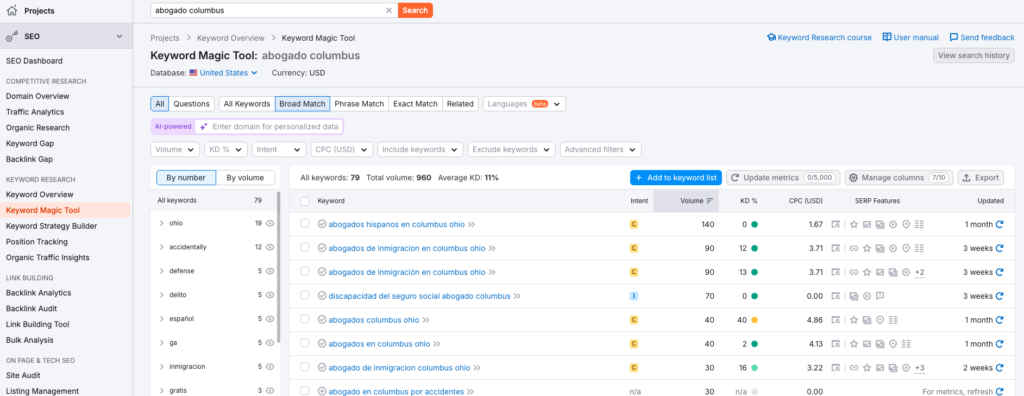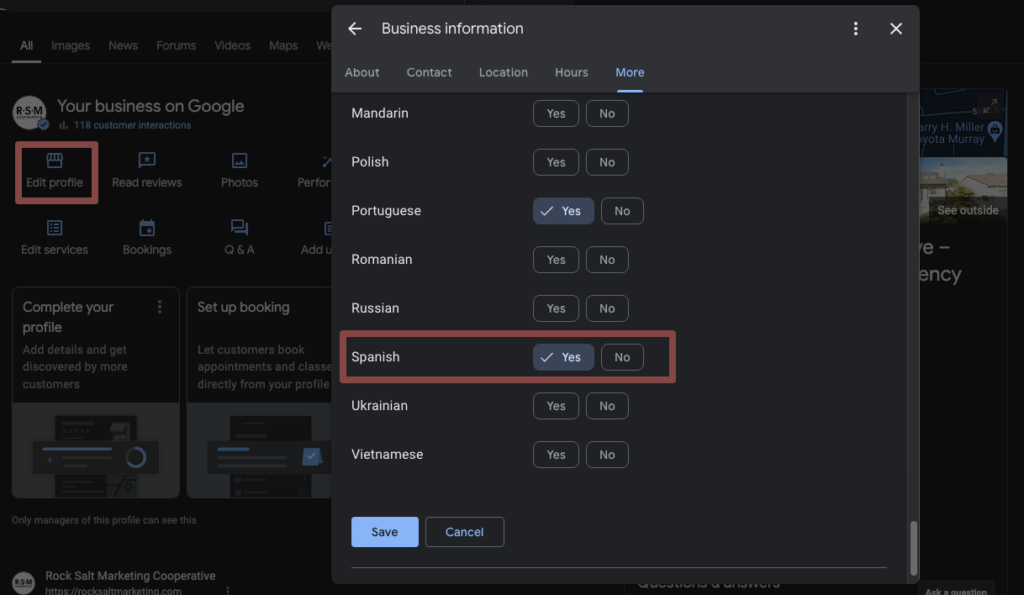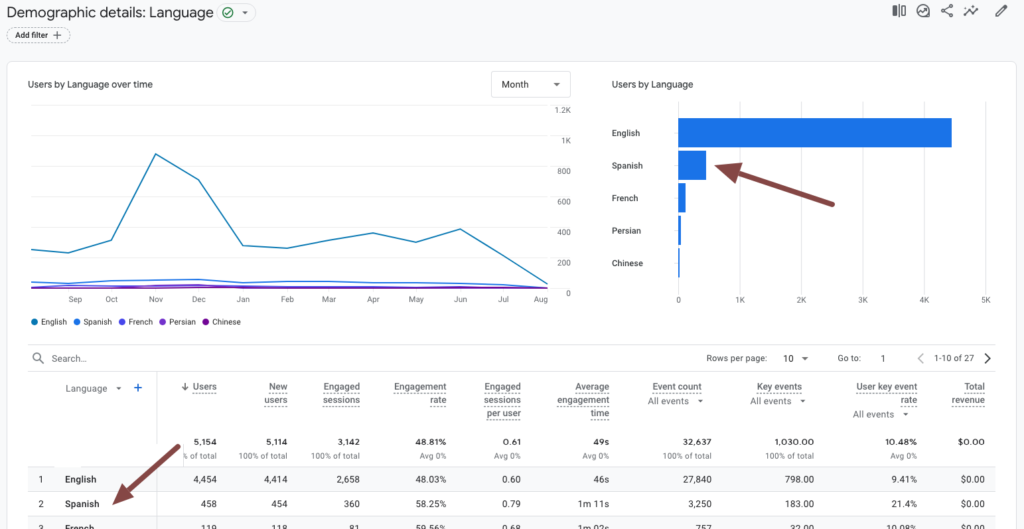In today’s global market, reaching Spanish-speaking audiences can be a game-changer for your business. Whether you’re a multinational corporation or a local business operating in Spanish-speaking communities, understanding and implementing Spanish-language SEO is essential for maximizing your online presence. This guide will walk you through the key strategies to execute a successful SEO campaign in Spanish.
But first, a few caveats: In this article, I’ll cover aspects of search engine optimization that are unique to SEO campaigns involving multilingual websites. I’ll focus specifically on Spanish-language SEO, as that’s what I’m most familiar with and what Rock Salt Marketing specializes in. However, this article won’t comprehensively cover all components of SEO and how to technically execute them. For instance, I will discuss how you should approach important SEO factors such as onsite copy creation, link building, and Google Business Profile optimization to execute an effective Spanish-language SEO campaign, but I won’t delve into the specifics of how each of those items is accomplished. For that information, I recommend Moz’s Beginner’s Guide to SEO.
With that out of the way, let’s start by defining “Spanish SEO.”
What is Spanish SEO?
First, Spanish SEO is not search engine optimization done in Spain. Rather, Spanish SEO is the process of optimizing your website and its content to rank higher in search engine results pages (SERPs) for Spanish-language queries. While I acknowledge that “Spanish SEO” may be a misnomer, in this article I’ll use the terms “Spanish-language SEO” and “Spanish SEO” interchangeably. Successfully implementing SEO in Spanish involves not only translating existing content but also understanding the unique behaviors and preferences of Spanish-speaking searchers.
Why Does Spanish SEO Matter?
With nearly 500 million native Spanish speakers worldwide (the second most spoken native language in the world, after Mandarin Chinese), the potential reach of Spanish-language SEO is enormous. In recent years, the growth of Spanish-speaking internet users has been substantial, particularly in the United States. With 42 million people aged five or older speaking Spanish in the home, Spanish is the second most spoken language in the country. Even more, the vast majority of this large population actively uses the internet. In fact, as of January 2024, Spanish was the second most frequently used language in web content.
A significant number of internet-savvy Spanish speakers turn to Google for their searches. Data from Statista indicates that in 2020, Google accounted for over 90% of the market share in search engines among Spanish-speaking users. Additionally, while many Spanish speakers have been conditioned by US search structure and culture to conduct their searches in English, most native Spanish speakers in the US are more likely to engage with content in their original tongue.
By effectively targeting this audience, businesses can tap into a rapidly growing online market, leveraging Spanish-language SEO to enhance visibility and engagement. Here are some key benefits of prioritizing SEO in Spanish:
- Expand your audience: Reach a broader and more diverse group of potential customers.
- Increase engagement: Provide content that resonates with Spanish-speaking users, leading to higher engagement rates.
- Boost conversions: Localized content can improve trust and credibility, ultimately driving more conversions such as qualified phone calls, form submissions, emails, or visits to your storefront.
How To Do Spanish-Language SEO
- Tools with Spanish-Language Databases
- Spanish-Language Keyword Research
- Onsite Copy & Metadata
- Site/URL Structure
- Spanish-Language Link Building
- Google Business Profile (GBP) Optimization
- Tracking and Monitoring Performance
Executing a successful Spanish SEO campaign requires a systematic approach tailored to the nuances of this diverse market. Below, I’ll delve into essential strategies that encompass key areas such as Spanish-language keyword research, onsite optimization, content creation, and link building. By implementing these strategies, you can position your brand effectively to connect with your Spanish-speaking audiences. Additionally, I’ll explore best practices for optimizing your Google Business Profile, ensuring your business stands out in local searches. Each of these components is critical for creating a cohesive and impactful Spanish-language SEO strategy that delivers real results. Each of these components requires a special set of tools. Let’s take a look at those tools before discussing strategy.
Tools with Spanish-Language Databases
Effective Spanish-language SEO starts with the right tools. Some popular SEO tools that feature databases for searches in Spanish include:
- SEMrush: Offers comprehensive keyword research and SEO analytics for Spanish-speaking markets.
- Ahrefs: Provides detailed insights into Spanish-language backlinks and competitive analysis.
- Google Keyword Planner: Useful for finding relevant keywords in Spanish.
- Google Trends: An invaluable tool for identifying trending topics and search queries in Spanish. It allows you to analyze the popularity of specific keywords over time, helping you to align your content strategy with current user interests in the Spanish-speaking market. By leveraging Google Trends, you can fine-tune your keyword selection and ensure your content remains relevant and engaging for your target audience.
- AnswerThePublic: A valuable resource for understanding the questions and topics that resonate with Spanish-speaking audiences, helping you to create content that directly addresses their interests and needs.
Integrating these tools into your Spanish SEO strategy will empower you to optimize your campaigns effectively, ensuring you reach and engage your target audience with precision.
Spanish-Language Keyword Research
Keyword research is the foundation of any SEO campaign. Conducting keyword research for Spanish-language SEO requires an understanding of the unique search habits and linguistic characteristics of Spanish-speaking audiences. Unlike English, which has a more standardized vocabulary, Spanish varies significantly by region, with distinct dialects and informal language that influence search behaviors. For example, a term commonly used by the country’s Mexican-American population might differ from that used by Spanish-Americans or Chilean-Americans, making it crucial to tailor your keyword strategy to the specific demographic you aim to reach. While an individual originally from Baja California might search for a “carro,” a man from Spain may ask Google for “coche” results, and a Chilean woman would type “auto.” Identify the keywords with favorable search volume in your region using a tool like Semrush or Ahrefs.

Additionally, Spanish speakers often employ different search phrases or synonyms when looking for the same product or service. The use of diminutives (such as “zapatillas” instead of “zapatos” for sneakers or shoes) is more prevalent in certain cultures, suggesting that a keyword analysis should not only focus on direct translations but should also explore how regional vernacular and colloquial expressions may show up in search.
As I mentioned above, many Spanish-speaking Americans actually tend to conduct their searches in English. Don’t discount that possibility with your situation! You can check demographic data gathered in Google Analytics to see the predominant languages of your audience. If you can isolate a segment of your audience that you are confident speaks predominantly Spanish, if their browser is set to English, that’s probably the best indication we can obtain that they most likely search in English as well. You can also check the language of the queries recorded in Google Search Console or even survey your audience. Nevertheless, keep in mind that, as mentioned above, even Spanish-speaking searchers who submit their queries in English will likely engage more favorably with content presented in their native tongue.
Onsite Copy
Once you identify your target keywords, it’s crucial to consider how to effectively convey your message in Spanish whether you’re writing new copy or translating old content. This leads us to the topic of Manual Spanish Translation vs. Automatic Plugin Translation.
Manual Spanish Translation Vs. Automatic Plugin or AI Translation
While automatic translation plugins and AI can be convenient, they often lack the nuance and accuracy of manual translation. Professional translators can ensure your content is both grammatically correct and culturally relevant. Additionally, plugins generally translate copy after the search engine has crawled your web page. Since the Spanish-language copy the user is viewing isn’t written into the page’s HTML, Google, Bing, and other search engines cannot recognize a page’s Spanish-language version for their algorithms. To have search engines understand the page as a Spanish version, a bona fide Spanish-language version of the page must be published on the site.
In this image, you can see the hero section of this lawyer’s site before and after it’s translated with the GTranslate WordPress plugin. Not only does the plugin impact the responsiveness and layout shift of the page, but if you view the page’s source code after the plugin translates its copy, this section is still represented in English in the HTML:

This is the content that Google will see when crawling the page, whether or not a plugin has translated the page:

Another convenient option that many business owners opt for is AI translation, While AI translation has made significant strides, it still requires careful consideration when targeting a specific audience. While leveraging AI tools can expedite the translation process, it is essential to ensure that the output resonates with your Spanish-speaking audience. Of course, inputting verbiage identified through exhaustive keyword research can enhance the relevance of the AI-generated content. However, to avoid potential pitfalls such as awkward phrasing or a robotic feel, enlisting a fluent Spanish speaker to, at the very least, proofread the translation is advisable. This ensures that the final product not only captures the intended message but also flows naturally and engages your audience effectively.
Metadata
Ensure that all metadata, including titles, descriptions, and alt text, is translated and optimized for Spanish-language keywords. Metadata plays a crucial role in how search engines understand and rank your content.
When translating, pay special attention to Spanish-specific characters such as tildes (~), acute accents (e.g., “é” or “á”), and diaereses (ü). These characters can significantly alter the meaning of words and, consequently, the effectiveness of your SEO strategy. For instance, the word “taco” (without an accent) refers to a type of food, whereas “tácito” (with an accent) means “implicit.”
Additionally, in some systems, character limits for meta titles and descriptions are determined by pixel count rather than number of characters. This means that characters with tildes, accents, or diaereses may occupy more of a pixel limit than a standard letter would.
Ensure that your meta titles and descriptions accurately reflect the correct spelling in Spanish while staying within character limits. This not only enhances user experience but also boosts your search engine ranking by aligning with the search habits of Spanish-speaking audiences.
Site/URL Structure
Once Spanish-speaking users arrive at your website to enjoy the elegant content you just published, it’s crucial that they can easily navigate through your site. Here are some ways to optimize your site structure for multiple languages:
- Avoid Subdomains: Rather than using subdomains, I recommend using subdirectories (e.g., https://yoursite.com/es/) for Spanish content to yield a smoother navigation experience and better search performance.
- Convertibility: Ensure that calls-to-action, navigation, forms, and other elements are fully translated into Spanish when users land on a Spanish-language version of a page. You should make it as easy as possible for your visitors to click through your website and purchase your product or service.
Structure Your Site For Google and Yandex With Hreflang
Hreflang attributes are an essential component of SEO strategy for websites serving audiences in multiple languages, including those featuring Spanish-language content alongside English or other languages. These attributes inform search engines about the language and geographical targeting of a webpage, ensuring that users are directed to the most relevant version of a site based on their language preferences and location. By implementing hreflang tags, you can prevent issues such as duplicate content penalties (when used in conjunction with proper canonicalization practices) and ensure a better user experience, as search engines will present users with the appropriate language version of your content, whether it’s Spanish, English, or otherwise.
For instance, if a user in Spain searches for a product, hreflang tags enable Google to prioritize the Spanish version of a product page (perhaps even one that you tailored specifically for a Spanish audience—that is, for Spaniards), ensuring that it appears in their search results. This targeted approach not only enhances visibility but also increases the likelihood of engagement and conversions. When configuring hreflang attributes, it’s vital to ensure they’re correctly set up and accurately represent your language offerings, creating seamless navigation for your audience. This attention to detail strengthens your site’s credibility and relevance, ultimately contributing to more successful, language-specific search strategies.
For an in-depth guide on how to implement Hreflang, check out the Ahrefs blog.
Spanish-Language Link Building
Effective link building is vital for optimizing your Spanish SEO efforts. Focus on building links on sites that attract traffic predominantly from the regions where your target audience searches from. Here are some strategies to enhance your Spanish-language link building:
- Local directories: Submit your site to Spanish-language directories and business listings. Not all directories are created equal; start with those that are frequently used by your audience. SparkToro can oftentimes be useful for determining which platforms these are.
- Guest posts: Write guest posts for reputable Spanish-language blogs and websites.
- Local influencers: Collaborate with Spanish-speaking influencers to create high-quality backlinks.
- Manual outreach: Reach out directly to relevant Spanish-language websites and blogs for potential partnerships and backlink opportunities, while avoiding paid links. Furthermore, contact websites that have mentioned your brand without linking to you, as well as those that link to competitors.
Google Business Profile Optimization
To effectively reach your Spanish-speaking customers in local searches (either in the SERPs or Google Maps), optimizing your Google Business Profile (formerly Google My Business) is crucial. This is applicable to businesses that either have a storefront or operate in service areas. Here are 3 key steps to enhance your online visibility:
- Spanish descriptions: You can provide your business description in both English and Spanish, or simply mention that you offer Spanish language assistance (e.g., ¡Se habla español!).
- Local reviews: Encourage satisfied Spanish-speaking customers to leave reviews, boosting your credibility within the community—extra points if they leave their reviews in Spanish!
- Spanish language assistance attribute: Don’t forget to select Spanish as a language assistance offering under the “service options” section in your Google Business Profile editor. This notifies your clientele that you can serve them even if they don’t speak English.

Tracking and Monitoring Performance
Once your Spanish-language SEO campaign is up and running, it’s crucial to track and monitor its performance. The data you gather can be critical in letting you know what’s working and what needs to be adjusted for better results. Focus on the following metrics:
Keyword Rankings
Use SEO tools like Semrush, Ahrefs, or Moz to monitor how your Spanish-language keywords are performing. Most tools now allow you to see how keywords are performing in specific areas. This can be helpful if the region you operate in has specific Hispanic communities that you’d like to address. Adjust your strategy based on how certain keywords are driving traffic and conversions from your target audience.
Organic Traffic
Analyze your site’s organic traffic to see how much of it comes from Spanish-speaking users or select communities. Tools like Google Analytics can help you segment traffic by language and region.

Conversions
Ultimately, the success of your SEO campaign should be measured by conversions. Typical conversions include phone calls, contact form submissions, emails, sales, or downloads, among others. Track how many Spanish-speaking users complete desired actions on your site, whether that’s making a purchase, signing up for a newsletter, or filling out a contact form. If your Spanish-speaking audience isn’t converting as favorably as other audiences, consider whether you’re addressing them properly. Revisit each of the items above to determine if there are ways you can improve performance.
Build Your Spanish-Speaking Clientele with Rock Salt Marketing
Executing a successful Spanish-language SEO campaign involves more than just translating your content with a plugin. It requires a deep understanding of your Spanish-speaking audience, the proper tools, and a strategic approach to keyword research, onsite optimization, and link building. By following these guidelines, you can tap into a vast and growing market, boosting your online presence and driving significant business growth. If you’re ready to take your SEO to the next level and reach more Spanish-speaking customers, contact Rock Salt Marketing Cooperative about our unparalleled Spanish SEO services. Our experienced team of native and fluent Spanish speakers knows the ins and outs of the online Spanish-language search market and is here to help you succeed!




